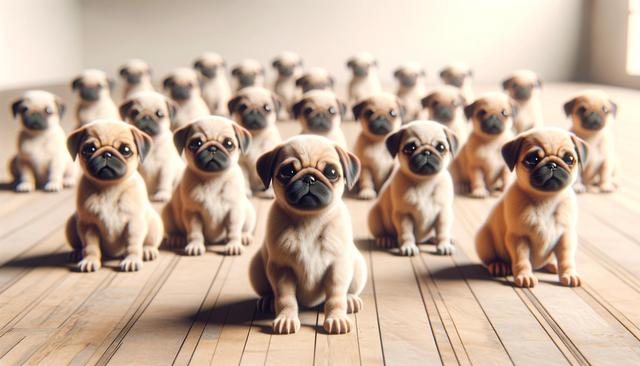
Getting to Know Pug Puppies: A Delightful Companion for Any Home
The Unique Personality of Pug Puppies
Pug puppies are widely adored for their quirky and endearing personalities. From the moment they open their eyes, these little dogs display a strong sense of curiosity and affection toward their human companions. Known for their social nature, pugs thrive on interaction and are generally very friendly with both people and other animals. Their temperament is typically calm and even-tempered, making them a good match for families, singles, and seniors alike.
One reason pug puppies are so well-regarded is their consistent desire to be part of the action. They often follow their owners from room to room, eager to be included in daily routines. This clingy yet charming behavior makes them excellent companions for those seeking emotional support or simply a loyal pet. They also have a humorous side, often displaying silly antics that bring laughter and joy to the home.
Despite their small size, pug puppies are surprisingly sturdy and confident. They rarely exhibit aggressive behavior, which contributes to their compatibility with children and other pets. However, early socialization is still important to nurture their friendly disposition. Training sessions that are short, positive, and reward-based tend to work well with their eager-to-please attitude.
Caring for a Pug Puppy
Owning a pug puppy comes with unique care requirements, particularly related to their distinctive physical traits. Their signature wrinkled faces, flat snouts, and compact bodies require specific attention to keep them healthy and comfortable. Regular cleaning of the facial wrinkles is essential to prevent skin infections, as moisture and debris can accumulate in these folds.
Due to their short muzzles, pug puppies are more susceptible to breathing issues and overheating. It’s important to keep them cool in warm weather and avoid vigorous exercise during hot days. A moderate amount of play and short walks are usually sufficient to keep them active without overexertion.
Here are a few essential care tips for pug puppies:
- Clean facial wrinkles gently but regularly to prevent irritation.
- Use a harness rather than a collar to avoid pressure on their neck.
- Feed a balanced diet to prevent obesity, a common concern for pugs.
- Provide mental stimulation with toys and training exercises.
Routine veterinary check-ups are also crucial, as pug puppies may be prone to certain health conditions like eye problems, hip dysplasia, and allergies. Early detection and preventive care can help manage these concerns effectively.
Training and Socialization
Training a pug puppy can be both a rewarding and amusing experience. These little dogs are intelligent and can learn commands quickly—especially when treats and praise are involved. However, they can also be a bit stubborn, so patience and consistency are key when guiding them through basic obedience and house training.
Pug puppies respond well to routines and positive reinforcement. Avoid harsh methods, as they are sensitive to tone and may become withdrawn if treated too sternly. Instead, keep sessions light-hearted and engaging. Short, frequent training periods tend to yield the best results, as pugs have relatively short attention spans.
Socialization is equally important during the early stages of a pug puppy’s life. Exposing them to a variety of environments, people, and other animals helps build their confidence and prevents fear-based behaviors later on. Puppy classes, park visits, and supervised playdates can all contribute to well-rounded social development.
Useful training practices include:
- Crate training for safe and comfortable rest time.
- Basic commands like “sit,” “stay,” and “leave it.”
- Leash training to promote calm walks.
- Reward-based potty training using treats and positive words.
Training is not just about discipline—it’s also a great way to bond with your pug puppy and establish trust. Their willingness to please makes them a joy to teach, even if a little patience is sometimes required.
Grooming and Maintenance
Though pug puppies have short coats, they do shed quite a bit. Regular grooming helps keep loose hair under control and supports healthy skin. Brushing them a few times a week with a soft-bristle brush can significantly reduce shedding and distribute natural oils across their coat.
Aside from brushing, pug puppies require routine grooming in several other areas. Their ears should be checked and cleaned weekly to prevent infections, especially since their folded ears can trap moisture. Nail trimming is also necessary to avoid discomfort or injury, and dental hygiene should not be overlooked.
Consider these key grooming tasks:
- Brushing 2–3 times per week to manage shedding.
- Wiping facial wrinkles with a damp cloth.
- Cleaning ears gently with vet-recommended solutions.
- Brushing teeth regularly with dog-specific toothpaste.
- Trimming nails every few weeks or as needed.
Frequent grooming not only keeps your pug puppy looking neat but also provides opportunities to check for any signs of health issues such as skin infections, lumps, or parasites. Making grooming a positive experience from an early age helps ensure cooperation as your pug grows older.
Creating a Comfortable Home Environment
Setting up your home for a pug puppy involves more than just having food and water bowls. These affectionate pups appreciate cozy, secure spaces where they can relax and feel safe. Providing a soft bed in a quiet area can help them settle in more easily, especially during their first few weeks in a new home.
Pug puppies are indoor dogs and should not be left outside for extended periods. Their compact bodies and short snouts make them sensitive to temperature extremes, so maintaining a climate-controlled indoor space is essential for their well-being. Baby gates can be helpful for restricting access to certain areas while still allowing them freedom to wander safely.
To keep a pug puppy happy and stimulated, consider adding the following:
- Interactive toys to engage their minds.
- Soft blankets or beds for comfort.
- Safe chew toys to support dental health.
- A designated potty area with consistent cues.
Creating a structured environment with predictable routines helps pug puppies feel secure. This includes regular feeding times, bathroom breaks, and play sessions. With these elements in place, your pug puppy will quickly adapt and thrive as a beloved member of your household.
Final Thoughts: Welcoming a Pug Puppy Into Your Life
Pug puppies bring warmth, laughter, and deep companionship into any home. Their affectionate nature, combined with a manageable size and adaptable temperament, makes them a popular choice for many types of households. Whether you live alone or have a bustling family, a pug puppy can easily become a cherished addition to your life.
With proper care, training, and attention to their unique needs, pug puppies grow into loyal and loving adult dogs. They may require a bit more grooming and health monitoring than some other breeds, but the reward is a deeply bonded relationship that lasts for years. If you’re ready to welcome a playful, devoted companion into your home, a pug puppy might be the perfect fit.


